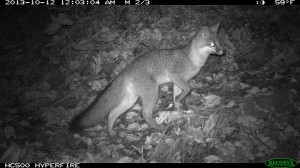Eyes in the Forest

Originally appears in the Winter 2015 issue
IT ALL STARTED with a dead deer and a trail camera. One chilly winter day I made an interesting discovery while out hiking a remote snowmobile trail. A fresh white tail deer carcass lay torn, scattered, and shredded in the newly fallen snow. Intrigued by what might return to clean up the mess, I borrowed a trail camera and strapped it to a nearby tree. My curiosity grew as I waited for visitors.
I bounced up and down in my chair with excitement while reviewing the images on my computer. It felt like Christmas morning. Coyotes, Fisher, Barred Owl, and Ravens! So many different species had feasted on the remaining deer flesh. By looking at the information stamped on the images (time, date, temperature, and moon phase) I knew exactly when the animals had visited. What else had I been missing all of this time?
I was hooked.
Trail cameras foster an appreciation
Since I first began experimenting with this technology several years ago my curiosity with the natural world has only escalated. As a naturalist and educator in northern Minnesota, I now own four trail cameras. My goal? Photograph as many wildlife species as possible. As I develop my skills as a tracker and trail-camera-photographer, the results continue to surprise me. I have documented everything from a Flying squirrel to a family of Canadian Lynx. I get so filled with excited anticipation that it takes nearly all of my self-control not to check the cameras too soon (as a general rule I try to leave a trail camera site alone for two weeks at a time).
When I first used trail cameras with students (kids and adults alike), I could easily see their curiosity and enthusiasm escalate as they began to ask questions. What feeds on a dead deer? What lives in that burrow? What uses this trail? Before the cameras, those were just interesting questions with interesting guesses. With the cameras, we know how to find the answers.
To view the photo-rich magazine version, click here.
If you are not already a subscriber, please subscribe to read the full article
Ryan Pennesi is a Mentor Naturalist at the Wolf Ridge Environmental Learning Center in Finland, Minnesota. After studying wildlife conservation at the University of Massachusetts Amherst, he worked as a crew leader with the Vermont Youth Conservation Corps and as an environmental educator with the Student Conservation Association in Western Massachusetts. Check out the Wildlife Blog that he writes at: http://wolf-ridge.org/category/trail-cam/
He posts trail camera photos each week here: https://www.facebook.com/pages/Wolf-Ridge-Environmental- Learning-Center/155083033396?fref=nf
Leave a Reply
You must be logged in to post a comment.





